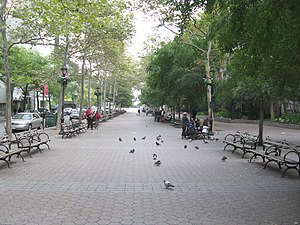47th Street (Manhattan)
 |
|
|---|---|

Dag Hammarskjold Plaza, located at the east end of 47th Street
|
|
| Other name(s) | Diamond Jewelry Way |
| Maintained by | NYCDOT |
| Length | 1.8 mi (2.9 km) |
| Location | Manhattan |
| Postal code | 10036, 10017, 10167 |
| Nearest metro station |
47th-50th Streets |
| Coordinates | 40°45′31″N 73°59′00″W / 40.7586°N 73.9832°WCoordinates: 40°45′31″N 73°59′00″W / 40.7586°N 73.9832°W |
| West end |
|
| East end | First Avenue in Midtown East |
| North | 48th Street |
| South | 46th Street |
| Construction | |
| Commissioned | March 1811 |
47th Street is an east-west running street between First Avenue and the West Side Highway in the borough of Manhattan in New York City. Traffic runs one way along the street, from east to west, starting at the headquarters of the United Nations. The street features the Diamond District in a single block (where the street is also known as Diamond Jewelry Way) and also courses through Times Square.
The Diamond District is between Fifth Avenue and Sixth Avenue in Midtown Manhattan. The district was created when dealers moved north from an earlier district near Canal Street and the Bowery that was created in the 1920s, and from a second district located in the Financial District, near the intersection of Fulton and Nassau Streets, which started in 1931, and also at Maiden Lane, which had existed since the 18th century. The move uptown started in 1941. The district grew in importance when Nazi Germany invaded the Netherlands and Belgium, forcing thousands of Orthodox Jews in the diamond business to flee Antwerp and Amsterdam and settle in New York City. Most of them remained after World War II, and remain a dominant influence in the Diamond District. A notable, long-time anomaly of the district was the famous Gotham Book Mart, a bookstore, which was located at 41 West 47th Street from 1946 to 2004.
The area is one of the primary centers of the global diamond industry (along with London – rough stones; the Antwerp diamond district in Belgium – historical but waning; Mumbai, India – increasing in significance; Diamond Exchange District, Ramat Gan, Israel – also growing; and Johannesburg, South Africa – the major historical source), as well as the premier center for jewelry shopping in the city. It is one of the largest diamond and jewelry districts in the United States, along with Jewelers' Row, Philadelphia and Los Angeles's Jewelry District, and it is the second oldest surviving jewelry district in the United States after Jewelers' Row, Philadelphia. Total receipts for the value of a single day's trade on the block average $400 million. An estimated 90% of diamonds in the United States enter through New York. There are 2,600 independent businesses located in the district, nearly all of them dealing in diamonds or jewelry. Most are located in booths at one of the 25 "exchanges" in the district, and in a public corridor to 46th Street. Commission based hawkers are also a common sight and they usually solicit business for stores located on the street level.
...
Wikipedia
